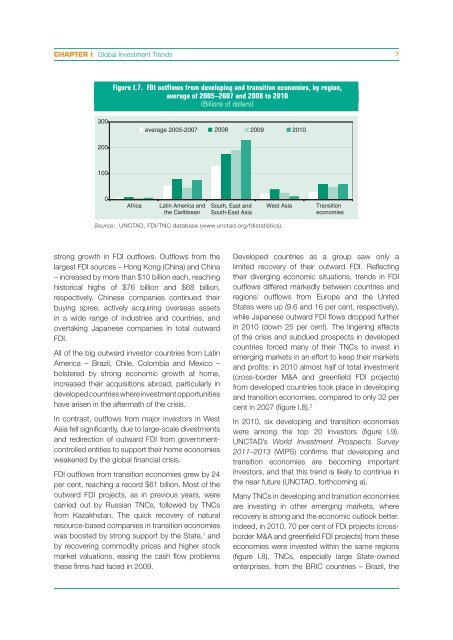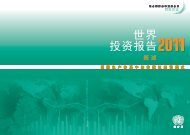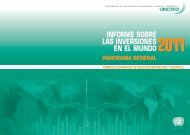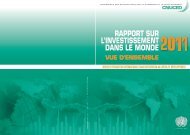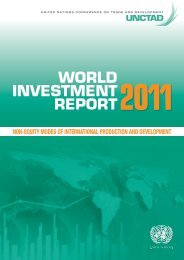CHAPTER I Global Investment Trends
CHAPTER I Global Investment Trends
CHAPTER I Global Investment Trends
You also want an ePaper? Increase the reach of your titles
YUMPU automatically turns print PDFs into web optimized ePapers that Google loves.
<strong>CHAPTER</strong> I <strong>Global</strong> <strong>Investment</strong> <strong>Trends</strong> 7<br />
300<br />
200<br />
100<br />
0<br />
Figure I.7. FDI outflows from developing and transition economies, by region,<br />
average of 2005–2007 and 2008 to 2010<br />
(Billions of dollars)<br />
Source: UNCTAD, FDI/TNC database (www.unctad.org/fdistatistics).<br />
strong growth in FDI outflows. Outflows from the<br />
largest FDI sources – Hong Kong (China) and China<br />
– increased by more than $10 billion each, reaching<br />
historical highs of $76 billion and $68 billion,<br />
respectively. Chinese companies continued their<br />
buying spree, actively acquiring overseas assets<br />
in a wide range of industries and countries, and<br />
overtaking Japanese companies in total outward<br />
FDI.<br />
All of the big outward investor countries from Latin<br />
America – Brazil, Chile, Colombia and Mexico –<br />
bolstered by strong economic growth at home,<br />
increased their acquisitions abroad, particularly in<br />
developed countries where investment opportunities<br />
have arisen in the aftermath of the crisis.<br />
In contrast, outflows from major investors in West<br />
Asia fell significantly, due to large-scale divestments<br />
and redirection of outward FDI from governmentcontrolled<br />
entities to support their home economies<br />
weakened by the global financial crisis.<br />
FDI outflows from transition economies grew by 24<br />
per cent, reaching a record $61 billion. Most of the<br />
outward FDI projects, as in previous years, were<br />
carried out by Russian TNCs, followed by TNCs<br />
from Kazakhstan. The quick recovery of natural<br />
resource-based companies in transition economies<br />
was boosted by strong support by the State, 1 and<br />
by recovering commodity prices and higher stock<br />
market valuations, easing the cash flow problems<br />
these firms had faced in 2009.<br />
average 2005-2007 2008<br />
2009 2010<br />
Africa Latin America and<br />
the Caribbean<br />
South, East and<br />
South-East Asia<br />
West Asia Transition<br />
economies<br />
Developed countries as a group saw only a<br />
limited recovery of their outward FDI. Reflecting<br />
their diverging economic situations, trends in FDI<br />
outflows differed markedly between countries and<br />
regions: outflows from Europe and the United<br />
States were up (9.6 and 16 per cent, respectively),<br />
while Japanese outward FDI flows dropped further<br />
in 2010 (down 25 per cent). The lingering effects<br />
of the crisis and subdued prospects in developed<br />
countries forced many of their TNCs to invest in<br />
emerging markets in an effort to keep their markets<br />
and profits: in 2010 almost half of total investment<br />
(cross-border M&A and greenfield FDI projects)<br />
from developed countries took place in developing<br />
and transition economies, compared to only 32 per<br />
cent in 2007 (figure I.8). 2<br />
In 2010, six developing and transition economies<br />
were among the top 20 investors (figure I.9).<br />
UNCTAD’s World <strong>Investment</strong> Prospects Survey<br />
2011–2013 (WIPS) confirms that developing and<br />
transition economies are becoming important<br />
investors, and that this trend is likely to continue in<br />
the near future (UNCTAD, forthcoming a).<br />
Many TNCs in developing and transition economies<br />
are investing in other emerging markets, where<br />
recovery is strong and the economic outlook better.<br />
Indeed, in 2010, 70 per cent of FDI projects (crossborder<br />
M&A and greenfield FDI projects) from these<br />
economies were invested within the same regions<br />
(figure I.8). TNCs, especially large State-owned<br />
enterprises, from the BRIC countries – Brazil, the


